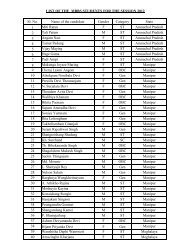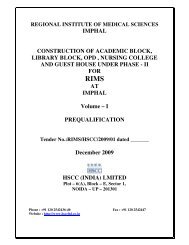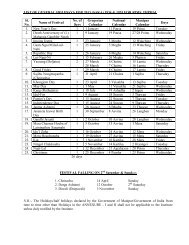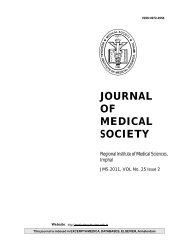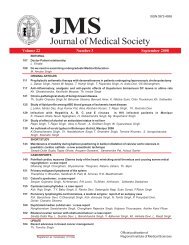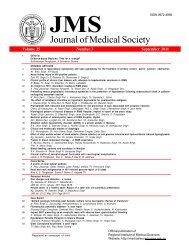Evidence-based Medicine: Time for a change? - Journal of Medical ...
Evidence-based Medicine: Time for a change? - Journal of Medical ...
Evidence-based Medicine: Time for a change? - Journal of Medical ...
Create successful ePaper yourself
Turn your PDF publications into a flip-book with our unique Google optimized e-Paper software.
ORIGINAL ARTICLE<br />
Table 3. Student found positive <strong>for</strong> ADHD in both the<br />
settings<br />
Class No. <strong>of</strong> No. <strong>of</strong> boys No. <strong>of</strong> girls No. <strong>of</strong> student<br />
student found found positive <strong>of</strong><br />
screened positive positive ADHD in<br />
two settings<br />
I 28 1 2 3<br />
II 55 6 3 9<br />
III 53 1 0 1<br />
IV 47 0 0 0<br />
V 47 0 0 0<br />
VI 43 0 0 0<br />
VII 39 0 0 0<br />
TOTAL 312 8 (2.9%) 5 (1.8%) 13 (4.17%)<br />
Out <strong>of</strong> the 312 students belonging to classes<br />
from I to VII who were recruited and screened<br />
<strong>for</strong> the study (as shown in table-1). The data<br />
collected from teachers shown that out <strong>of</strong> 312<br />
students screened, 17 students were<br />
screened positive <strong>of</strong> ADHD with a percentage<br />
<strong>of</strong> 5.45%. Out <strong>of</strong> which 10 were boys and 7<br />
were girls with a percentage <strong>of</strong> 3.23% and<br />
2.22% respectively.. From the data collected<br />
by parents it was found that out <strong>of</strong> the 17<br />
positive students, 13 <strong>of</strong> them were again<br />
screened positive – 8 boys and 5 girls,<br />
whereas 3 <strong>of</strong> them were found negative and<br />
1 <strong>of</strong> the student could not be traced as he had<br />
already dropped out <strong>of</strong> the school. Special<br />
focus was given on the above mentioned 17<br />
positive students (shown in table – 2,3).<br />
Putting the above two data together, it was<br />
found that out <strong>of</strong> the total <strong>of</strong> 312 students<br />
screened, 13 students were diagnosed<br />
positive <strong>of</strong> ADHD. So, it stands that 4.17 % <strong>of</strong><br />
the students were affected by ADHD.<br />
Discussion: Besides providing in<strong>for</strong>mation<br />
that can be compared with the child’s behavior<br />
at home, school setting can be used as an<br />
alternative setting <strong>for</strong> carrying out interventions<br />
and allows sampling <strong>of</strong> a broader spectrum<br />
and area <strong>of</strong> behavior. 12 Moreover, externalizing<br />
problems get reported more <strong>of</strong>ten by teachers<br />
and internalizing problems more <strong>of</strong>ten by the<br />
parents. 13 Keeping these views in mind, school<br />
was chosen as a plat<strong>for</strong>m to obtain samples<br />
<strong>for</strong> study. This has been done in several other<br />
studies. 14, 15. The sample consisting <strong>of</strong> 312<br />
children that were screened comprised <strong>of</strong> an<br />
almost equal proportion <strong>of</strong> girls and boys. This<br />
ensured proportional representation <strong>of</strong> both<br />
sexes. In the present study, in<strong>for</strong>mation from<br />
child, teacher and parents was used and the<br />
interviewer’s best judgment was applied to<br />
arrive at a final conclusion.<br />
The prevalence <strong>of</strong> ADHD in the current study<br />
was found to be 4.17 %. Though, the finding<br />
was agreed with several other studies. Studies<br />
by Kashani et al., 16 Cohen et al. 17 and<br />
Deivasigamani 14 have found higher rates while<br />
that by Esser et al 18 revealed lower rate <strong>of</strong><br />
prevalence. This difference could be attributed<br />
to variations in age group, in<strong>for</strong>mants,<br />
diagnostic system, diagnostic tools and<br />
sampling techniques. The higher rate <strong>of</strong> ADHD<br />
among boys than girls were similar to findings<br />
<strong>of</strong> Rutter et al., 19 and Of<strong>for</strong>d et al 20 .<br />
Conclusion: ADHD is not uncommon in<br />
school going children in Manipur. It is a barrier<br />
in the effective management <strong>of</strong> children at<br />
school and home. And yet many <strong>of</strong> the parents<br />
and teachers are not aware <strong>of</strong> the same.<br />
Present study could bring up awareness<br />
among the teachers and parents.<br />
Limitations: The present study had certain<br />
limitations. Inherent disadvantages <strong>of</strong><br />
sampling in schools remained. Subjects with<br />
severe ADHD, being probable school<br />
dropouts, were automatically left out. Certain<br />
socio-demographic and clinical variables<br />
such as peer adjustment, environment in<br />
neighborhood, parenting style and intelligence,<br />
which were not probed, kept room <strong>for</strong> future<br />
improvement.<br />
References<br />
1. American Psychiatric Association.<br />
Diagnostic and Statistical Manual <strong>of</strong> Mental<br />
Disorders. 4th ed. Washington, DC:<br />
American Psychiatric Association; 1994<br />
2. National Institute <strong>of</strong> Mental Health.<br />
“Attention Deficit Hyperactivity Disorder.”<br />
Department <strong>of</strong> Health and Human<br />
Services. National Institutes <strong>of</strong> Health.<br />
2006.<br />
48 JMS * JMS Vol 25 * Vol * No. 25 3 * No. * September, 1 * June, 2010 2011








